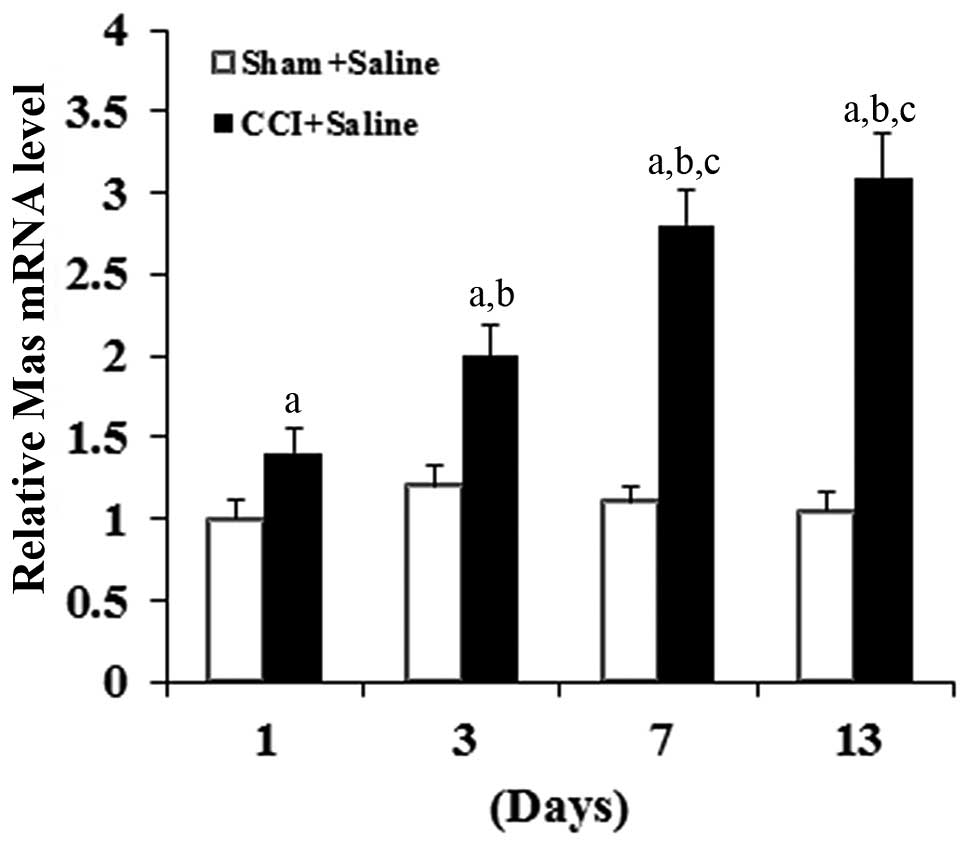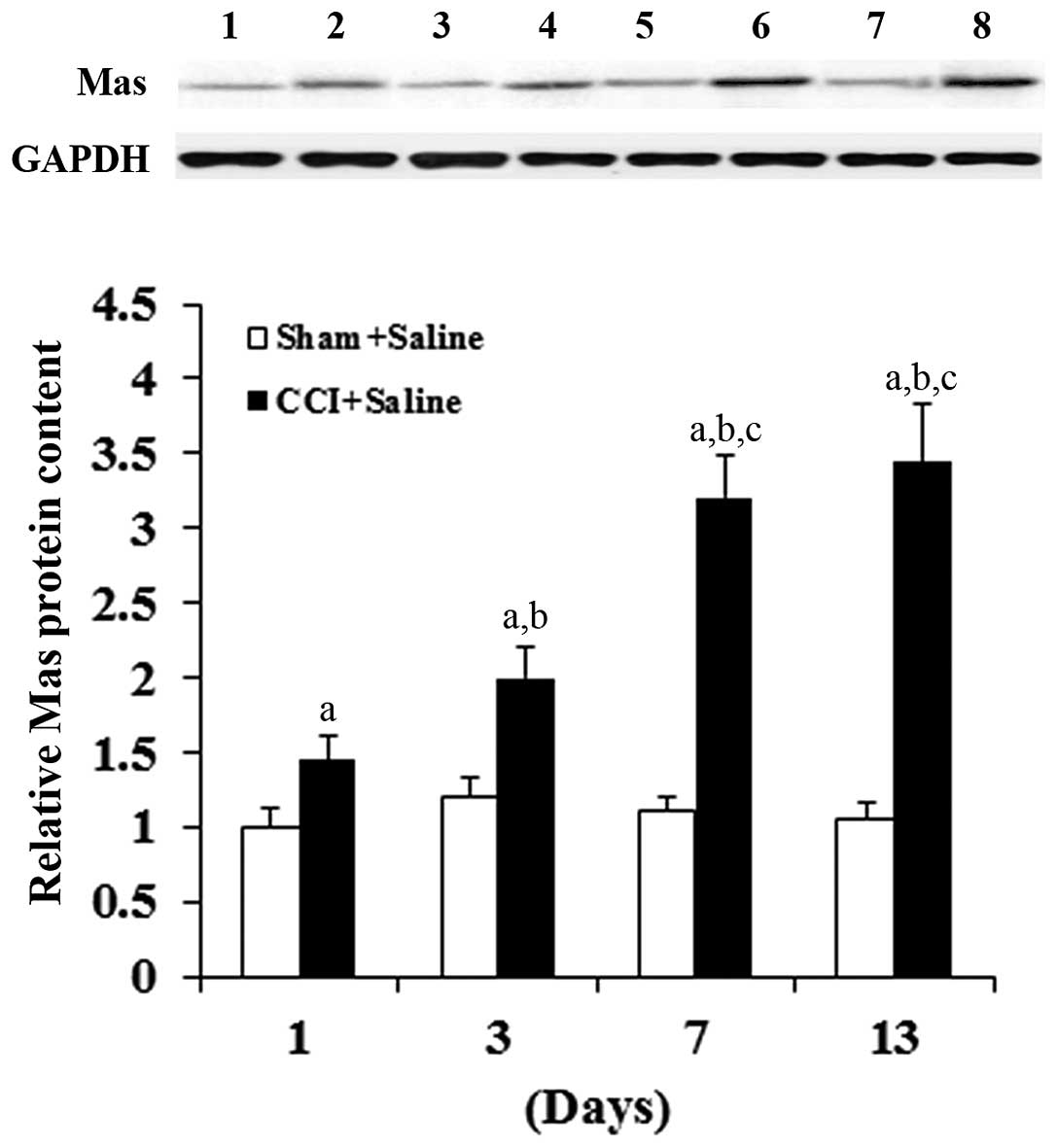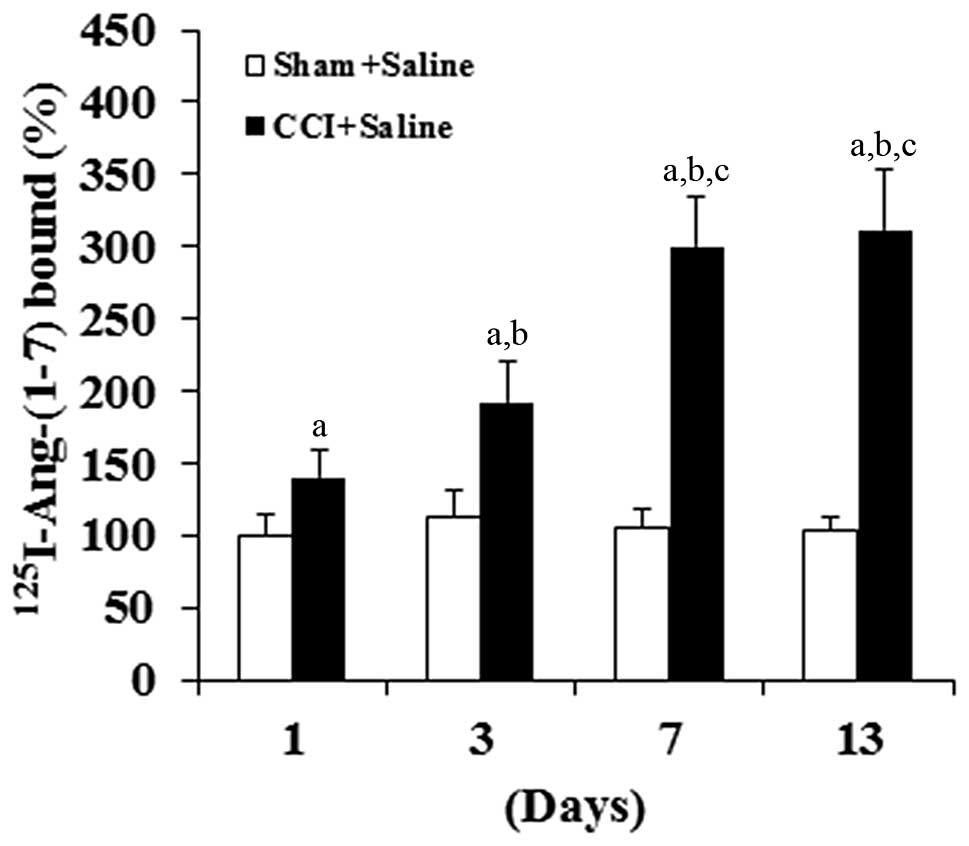|
1
|
Jensen TS, Baron R, Haanpüü M, Kalso E,
Loeser JD, Rice AS and Treede R: A new definition of neuropathic
pain. Pain. 152:2204–2205. 2011. View Article : Google Scholar : PubMed/NCBI
|
|
2
|
Grace PM, Hurley D, Barratt DT, Tsykin A,
Watkins LR, Rolan PE and Hutchinson MR: Harnessing pain
heterogeneity and RNA transcriptome to identify blood-based pain
biomarkers: A novel correlational study design and bioinformatics
approach in a graded chronic constriction injury model. J
Neurochem. 122:976–994. 2012. View Article : Google Scholar : PubMed/NCBI
|
|
3
|
Lin HC, Huang YH, Chao TH, Lin WY, Sun WZ
and Yen CT: Gabapentin reverses central hypersensitivity and
suppresses medial prefrontal cortical glucose metabolism in rats
with neuropathic pain. Mol Pain. 10:632014. View Article : Google Scholar : PubMed/NCBI
|
|
4
|
Obata K, Yamanaka H, Fukuoka T, Yi D,
Tokunaga A, Hashimoto N, Yoshikawa H and Noguchi K: Contribution of
injured and uninjured dorsal root ganglion neurons to pain behavior
and the changes in gene expression following chronic constriction
injury of the sciatic nerve in rats. Pain. 101:65–77. 2003.
View Article : Google Scholar : PubMed/NCBI
|
|
5
|
de Gasparo M, Catt KJ, Inagami T, Wright
JW and Unger T: International union of pharmacology. XXIII. The
angiotensin II receptors. Pharmacol Rev. 52:415–472.
2000.PubMed/NCBI
|
|
6
|
Pelegrini-da-Silva A, Martins AR and Prado
WA: A new role for the renin-angiotensin system in the rat
periaqueductal gray matter: Angiotensin receptor-mediated
modulation of nociception. Neuroscience. 132:453–463. 2005.
View Article : Google Scholar : PubMed/NCBI
|
|
7
|
Sakagawa T, Okuyama S, Kawashima N, Hozumi
S, Nakagawasai O, Tadano T, Kisara K, Ichiki T and Inagami T: Pain
threshold, learning and formation of brain edema in mice lacking
the angiotensin II type 2 receptor. Life Sci. 67:2577–2585. 2000.
View Article : Google Scholar : PubMed/NCBI
|
|
8
|
Pavel J, Tang H, Brimijoin S, Moughamian
A, Nishioku T, Benicky J and Saavedra JM: Expression and transport
of Angiotensin II AT1 receptors in spinal cord, dorsal root ganglia
and sciatic nerve of the rat. Brain Res. 1246:111–122. 2008.
View Article : Google Scholar : PubMed/NCBI
|
|
9
|
Ferreira AJ, Murça TM, Fraga-Silva RA,
Castro CH, Raizada MK and Santos RA: New cardiovascular and
pulmonary therapeutic strategies based on the
Angiotensin-converting enzyme 2/angiotensin-(1–7)/mas receptor
axis. Int J Hypertens. 2012:1478252012. View Article : Google Scholar : PubMed/NCBI
|
|
10
|
Raizada MK and Ferreira AJ: ACE2: A new
target for cardiovascular disease therapeutics. J Cardiovasc
Pharmacol. 50:112–119. 2007. View Article : Google Scholar : PubMed/NCBI
|
|
11
|
Vickers C, Hales P, Kaushik V, Dick L,
Gavin J, Tang J, Godbout K, Parsons T, Baronas E, Hsieh F, et al:
Hydrolysis of biological peptides by human angiotensin-converting
enzyme-related carboxypeptidase. J Biol Chem. 277:14838–14843.
2002. View Article : Google Scholar : PubMed/NCBI
|
|
12
|
Der Sarkissian S, Huentelman MJ, Stewart
J, Katovich MJ and Raizada MK: ACE2: A novel therapeutic target for
cardiovascular diseases. Prog Biophys Mol Biol. 91:163–198. 2006.
View Article : Google Scholar : PubMed/NCBI
|
|
13
|
Rice GI, Thomas DA, Grant PJ, Turner AJ
and Hooper NM: Evaluation of angiotensin-converting enzyme (ACE),
its homologue ACE2 and neprilysin in angiotensin peptide
metabolism. Biochem J. 383:45–51. 2004. View Article : Google Scholar : PubMed/NCBI
|
|
14
|
Stanziola L, Greene LJ and Santos RA:
Effect of chronic angiotensin converting enzyme inhibition on
angiotensin I and bradykinin metabolism in rats. Am J Hypertens.
12:1021–1029. 1999. View Article : Google Scholar : PubMed/NCBI
|
|
15
|
Ferreira AJ and Santos RA: Cardiovascular
actions of angiotensin-(1–7). Braz J Med Biol Res. 38:499–507.
2005. View Article : Google Scholar : PubMed/NCBI
|
|
16
|
Gomes ER, Santos RA and Guatimosim S:
Angiotensin-(1–7)-mediated signaling in cardiomyocytes. Int J
Hypertens. 2012:4931292012. View Article : Google Scholar : PubMed/NCBI
|
|
17
|
Santos RA, Campagnole-Santos MJ and
Andrade SP: Angiotensin-(1–7): An update. Regul Pept. 91:45–62.
2000. View Article : Google Scholar : PubMed/NCBI
|
|
18
|
Cao L, Xun J, Jiang X and Tan R: Propofol
up-regulates Mas receptor expression in dorsal root ganglion
neurons. Pharmazie. 68:677–680. 2013.PubMed/NCBI
|
|
19
|
Costa AC, Becker LK, Moraes ER, Romero TR,
Guzzo L, Santos RA and Duarte ID: Angiotensin-(1–7) induces
peripheral antinociception through mas receptor activation in an
opioid-independent pathway. Pharmacology. 89:137–144. 2012.
View Article : Google Scholar : PubMed/NCBI
|
|
20
|
Bennett G and Xie Y: A peripheral
mononeuropathy in rat that produces disorders of pain sensation
like those seen in man. Pain. 33:87–107. 1988. View Article : Google Scholar : PubMed/NCBI
|
|
21
|
Zanella JM, Burright EN, Hildebrand K,
Hobot C, Cox M, Christoferson L and Mckay WF: Effect of etanercept,
a tumor necrosis factor-alpha inhibitor, on neuropathic pain in the
rat chronic constriction injury model. Spine (Phila Pa 1976).
33:227–234. 2008. View Article : Google Scholar : PubMed/NCBI
|
|
22
|
Melli G and Höke A: Dorsal root ganglia
sensory neuronal cultures: A tool for drug discovery for peripheral
neuropathies. Expert Opin Drug Discov. 4:1035–1045. 2009.
View Article : Google Scholar : PubMed/NCBI
|
|
23
|
Gironacci MM, Adamo HP, Corradi G, Santos
RA, Ortiz P and Carretero OA: Angiotensin (1–7) induces MAS
receptor internalization. Hypertension. 58:176–181. 2011.
View Article : Google Scholar : PubMed/NCBI
|
|
24
|
Mizoguchi H, Watanabe C, Yonezawa A and
Sakurada S: New therapy for neuropathic pain. Int Rev Neurobiol.
85:249–260. 2009. View Article : Google Scholar : PubMed/NCBI
|
|
25
|
Silva DM, Vianna HR, Cortes SF,
Campagnole-Santos MJ, Santos RA and Lemos VS: Evidence for a new
angiotensin-(1–7) receptor subtype in the aorta of Sprague-Dawley
rats. Peptides. 28:702–707. 2007. View Article : Google Scholar : PubMed/NCBI
|
|
26
|
Medeiros MA, França MS, Boileau G, Juliano
L and Carvalho KM: Specific fluorogenic substrates for neprilysin
(neutral endopeptidase, EC 3.4.24.11) which are highly resistant to
serine- and metalloproteases. Braz J Med Biol Res. 30:1157–1162.
1997. View Article : Google Scholar : PubMed/NCBI
|


















